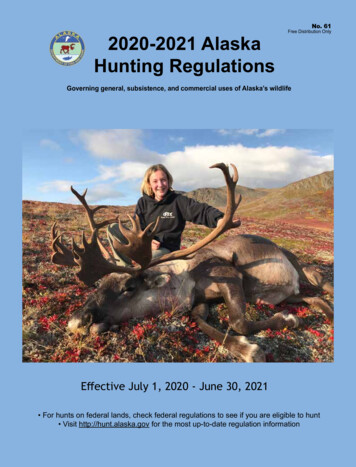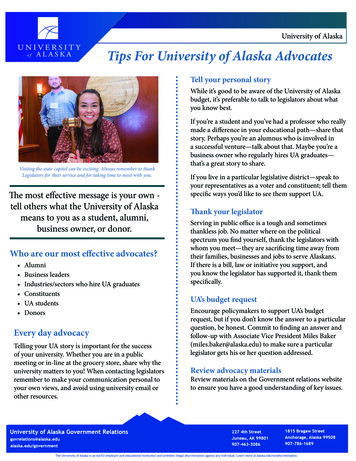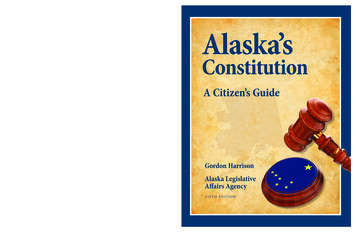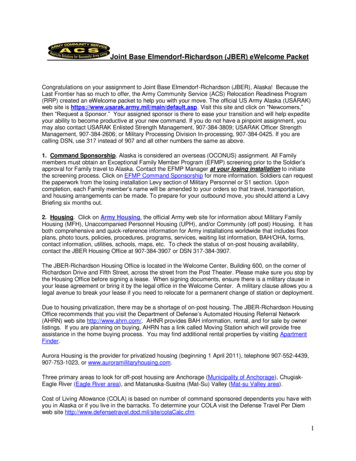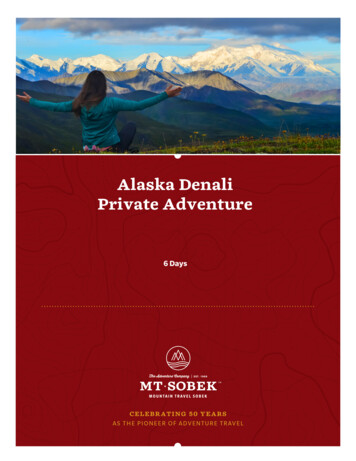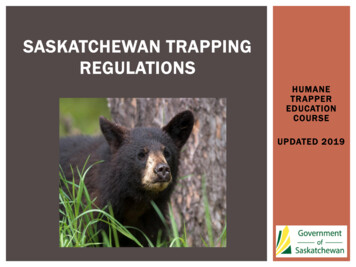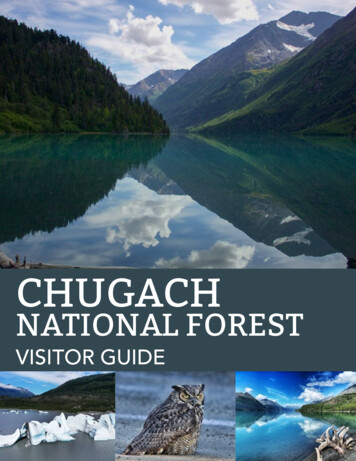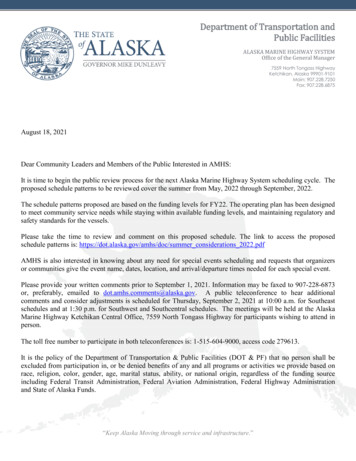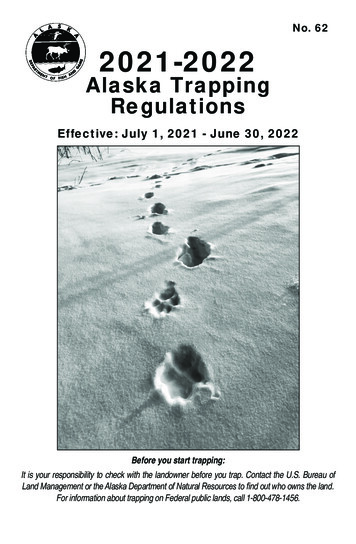
Transcription
No. 622021-2022Alaska TrappingRegulationsEffective: July 1, 2021 - June 30, 2022Before you start trapping:It is your responsibility to check with the landowner before you trap. Contact the U.S. Bureau ofLand Management or the Alaska Department of Natural Resources to find out who owns the land.For information about trapping on Federal public lands, call 1-800-478-1456.
NOTICE: THESE REGULATIONS ARE NOT COMPLETEOR QUOTED VERBATIM FROM THE ALASKA STATUTES.For more information regarding trapping regulations, consult your localDivision of Wildlife Conservation office:Anchorage. 267-2257Bethel. 543-2839Cordova. 424-3215Craig . 826-2561Delta Junction. 895-4484Dillingham. 842-2334Douglas. 465-4265Fairbanks. 459-7206Galena. 656-1345Glennallen. 822-3461Homer. 235-8191Ketchikan. 225-2475ADF&GBoard of GameMembersVacantStosh Hoffman Jr. BethelJerry Burnett.JuneauOrville Huntington.HusliaAl Barrette.FairbanksJacob Fletcher.TalkeetnaLynn Keogh Jr.AnchorageKing Salmon. 246-3340Kodiak. 486-1880Kotzebue. 442-3420McGrath. 524-3323Nome. 443-2271Palmer. 746-6300Petersburg. 772-3801Sitka. 747-5449Soldotna. 262-9368Tok. 883-2971Utqiagvik. 852-3464Governor of AlaskaMike DunleavyCommissioner of Fish and GameDoug Vincent-LangDirectorDivision of Wildlife ConservationEddie GrasserOn the cover: Trotting wolf tracks. Notice the change in snow packas the tracks break through deeper powder before hitting firmer,windblown snow. Photo Credit: Mike Taras.This publication was released by the Alaska Department of Fish and Gameand was printed by Assets Printing. (AS 44.99.210).The State of Alaska is an Affirmative Action/Equal Opportunity Employer.Contact the Division of Wildlife Conservation at (907) 465-4190 foralternative formats of this publication.Comments or questions regarding this publication may be emailed tonatalie.weber@alaska.gov.2
Table of ContentsTrapping Regulation Changes. 4Incidental Catch. 14General Information. 5Use of Furbearers. 14Reporting Violations. 6Know Who Owns the Land.6Licenses and Fees. 7Resident Licenses and Fees. 7Nonresident Licenses and Fees. 8Where Can I Get aTrapping License?. 8How Long Is My TrappingLicense Valid?. .9What If I Lose My TrappingLicense?. 9Fur Dealer License. 9Permits. 10Permit for Taking Furbearerswith Game. 10Permit for Exporting Fur . 10Permit for Capturing WildFurbearers for Fur Farming. 10Permit for Controlling Beavers. 11Discretionary TrappingRequirements.11Trapper Harassment Law.11Bag Limits. 12Methods and Means. 12Bait for Trapping. 12Methods for Trapping. 13Salvage of Furbearers. 14Marked or Tagged Game . 14Sealing Furbearers. 15Buying and Selling Furbearers. 15Possession and Transportation. 16Definitions. 16Areas Identified by Board of Gamefor Active Management of WolfPopulations. 18Southeast Alaska:Units 1-5. 20Southcentral Alaska:Units 6-8, 14C and 15. 25Central/Southwest Alaska:Units 9-11, 13,14A, 14B, 16 and 17. 30Interior/Northeast Alaska:Units 12, 19-21,24, 25, 26B, and 26C. 35Rabies Information. 40Arctic/Western Alaska:Units 18, 22, 23, and 26A. 41Temporary FurbearerSealing Certificate. 45Code of Ethics. 483
Trapping Regulation ChangesThis is a summary of changes adopted by the Alaska Board of Gamefor regulatory year 2021-2022. This is not a comprehensive list of all thedetailed changes. It is your responsibility to read the Alaska TrappingRegulations carefully for complete information.WolfUnit 2: all wolves taken in Unit 2 must be sequentially numbered ormarked by the trapper, the trapper must call the ADF&G Ketchikanoffice at (907) 225-2475 within 7 days of take to report the date andlocation of take, and all hides must be sealed within 15 days of take.Attention Trappers:Remember to act responsibly by trapping in ways thatminimize conflict between trappers and other users. Failingto do so may jeopardize the future of trapping in Alaska. Formore information please see page 6 and the back cover.Best of luck this trapping season!4
General InformationMuch of the information in the front of this book is presented in “common sense”language to help trappers understand requirements. It is not a legal document andis not quoted verbatim from state law. For further details, contact your local AlaskaDepartment of Fish and Game (ADF&G), Division of Wildlife Conservation representative (phone numbers are listed on page 2).For the purposes of this booklet, trapping means the taking of furbearers underauthority of a trapping license. As explained later, some individuals may trap furbearers without a license, but if a license is required, then you need to carry it with youwhen you are trapping.Most furbearers are taken with either traps (including foothold and killer-style orbody-grip traps) or snares, but can also be shot with firearms unless specificallyprohibited. General restrictions regarding the use of traps, snares, or firearms arepresented in the section titled “Methods and Means.” Restrictions that apply only toa specific species (such as beaver) are included with seasons and bag limits. Areasclosed to trapping are found at the beginning of the seasons and bag limits sectionof each region.Furbearers that may be taken with a trapping license are beaver, coyote, Arcticfox, red fox, fisher, lynx, marmot (Alaska or hoary marmot and woodchucks),marten, mink, muskrat, river otter, squirrel, weasel, wolf, and wolverine.Furbearers that are also classified as fur animals are: beaver, coyote, Arctic fox,red fox, lynx, and squirrel. Furbearers that are also classified as big game animalsare: wolf and wolverine.Species that are only classified as a furbearer may only be taken with a trappinglicense under trapping regulations. For example, if you want to shoot a marmot,then you must have a trapping license because this species is only classified as afurbearer and is only covered under trapping regulations.Furbearers that are also classified as fur animals or big game animals may be takeneither with a trapping license under trapping regulations or with a hunting license underhunting regulations. For example, if you want to shoot a wolf, which is considered afurbearer and a big game animal, and you have a trapping license, then you wouldfollow regulations in this booklet; if you have a hunting license, then you would followregulations in the Alaska Hunting Regulations for the current regulatory year.5
If an Alaska Wildlife Trooper, Alaska State Trooper, police officer or authorizedADF&G employee asks to see your license, locking-tags, harvest tickets, permits,bowhunter certification card, game or any equipment used to take game, you mustshow any or all of these items.If you trap near a highway, remember that it is against the law to leave any carcassesor entrails on a highway or the right-of-way. Please deposit these materials out ofsight of roads or trails.Act responsibly as a trapper and conservationist by trapping in ways to minimize conflictbetween trapping and other users, for example, avoid high recreational use areas.Avoid situations where you might catch a domestic dog or cat, such as near homesor trails frequently used by hikers, skijorers, dog mushers, or other people.Reporting ViolationsIf you observe a violation of Alaska’s Fish and Game laws, you can assist the AlaskaWildlife Troopers as well as be eligible for a reward by reporting the violation to thenearest office of the Alaska Wildlife Troopers or by calling the Alaska Fish and WildlifeSafeguard Hotline at 1-800-478-3377.Regulations are no joke. This is a joke:Why was the fox hunting snowshoe hares? Because it was in the mood for fast food!Know Who Owns the Land Where You Planto TrapAlthough regulations presented in this booklet may show an open season on certainfurbearers in a specific game management unit, local regulations, ordinances, orstate park rules may prohibit access, trapping, or the use of firearms, or require anaccess permit. It is your responsibility as a trapper to check with the landowner beforeyou trap. For information on land status, land ownership, and access contact: BLMPublic Information Center (Anchorage) at (907) 271-5960 or DNR Public InformationCenter (Anchorage) (907) 269-8400 or visit DNR’s website athttp://dnr.alaska.gov/mlw/index.htm.6
Licenses and FeesResident LicensesResidents who want to trap furbearers in Alaska need a trapping licenseunless they are: an Alaska resident under the age of 18; or an Alaska resident age 60 or older with a permanent identification card.This card may be applied for online at http://hunt.alaska.gov or at anyADF&G office.For the purposes of obtaining a trapping license, “resident” means(AS 16.05.940): a person (including an alien) who is physically present in Alaska with theintent to remain indefinitely and make a home here, has maintained thatperson’s domicile in Alaska for the 12 consecutive months immediatelypreceding this application for a license, and is not claiming residency orobtaining benefits under a claim of residency in another state, territory, orcountry; a member of the military service or U.S. Coast Guard who has been stationedin Alaska for the 12 consecutive months immediately preceding thisapplication for a license; or a dependent of a resident member of the military service or U.S. CoastGuard who has lived in Alaska for the 12 consecutive months immediatelypreceding this application for a license.Resident License FeesTrapping. 25.00Trapping & Hunting. 65.00Low-income Trapping, Hunting & Sport Fishing. 5.00Trapping, Hunting & Sport Fishing . 85.00Fur Dealer (biennial) . 150.00Low-income LicenseYou can obtain a special resident trapping, hunting, and sport fishing license for 5 if your family or household income is equal to or less than the most recentpoverty guidelines for the state set by the United States Department of Healthand Human Services for the year preceding the application. The 5 license is forhunting, trapping, and sport fishing; it is not a “subsistence” license. Low-incomelicense holders do not need king salmon or a state duck stamp, however, theymust still obtain any required harvest tickets, permits, or locking-tags.7
Nonresident LicensesNonresidents who want to trap furbearers in Alaska need a hunting andtrapping license.For the purposes of obtaining a trapping license,“nonresident” means:anyone who is not a resident of Alaska, but is a U.S. citizen (AS 16.05.940).Nonresident License FeesTrapping and HuntingFur Dealer (biennial) 405.00 500.00Where Can I Obtain a Trapping License?A trapping license can be obtained from any license vendor in the state oronline at http://hunt.alaska.gov. To get your license you may be asked toshow proof of your residency. It is against the law to falsify any requiredinformation such as how long you have been a resident of the state. In addition, you may not alter a trapping license once it has been issued to you,nor may you loan or transfer it to someone else. Similarly, you may not usesomeone else’s trapping license.In addition to a state trapping license, a trapping permit may be required onsome federal refuges, parks and monuments, private land, or military land.These permits can be obtained from the landowners.8
How Long Is My Trapping License Valid?The resident trapping license is valid from the date of issue until September 30 of the year following the date of purchase regardless of whetherpurchased singly or in combination with a hunting or sport fishing license. Ifyou purchase a resident hunting and trapping license on October 1, 2021,the hunting license part of it is only valid through December 31, 2021, butthe trapping part is valid through September 30, 2022.Nonresident trapping licenses are valid from the date of issue throughDecember 31 of the year in which they were purchased.What If I Lose My Trapping License?If you lose your license, you can obtain a duplicate from any license vendor for 5. At the time you purchase a duplicate, you must sign an affidavit indicatingthat you had previously purchased a trapping license during the same year.Fur Dealer LicenseA fur dealer license allows you to buy, barter, or resell animal skins. You donot need a fur dealer license to sell the raw fur you legally trapped nor doyou need a trapping or fur dealer license to buy raw fur for your own use.However, if you want to buy or barter animal skins for the purpose of resellingthem, you will need a fur dealer license. Applications for a fur dealer licenseare available online at www.adfg.alaska.gov/store. For additionalinformation, please contact ADF&G’s Licensing Section at (907) 465-2376.9
PermitsIn addition to a trapping license, permits may be necessary for taking furbearersunder special conditions or for shipping fur out of the state. If you obtain one of thepermits listed below, be aware it may have other requirements in addition to whatis explained in this book.Permit for Taking Furbearers with GameThe department may issue a permit to trap furbearers with the use of game furnishedby the state. A person using game for bait under this permit shall post a notice at thetrap site indicating the permit number.Permit for Exporting FurThere are federal licenses and permits needed to ship furs outside of the country.Please check with the U.S. Fish and Wildlife Service (USFWS) if you intend to shipfur out of Alaska to another country such as Canada. If you intend to ship a raw ortanned lynx, river otter, or wolf skin out of the country (for example from Alaska to afur dealer in Canada) you must obtain a federal wildlife export permit (also called aCITES permit), a federal import/export license, and arrange for inspection of all fursby a federal agent. In Alaska, these FEDERAL permits/licenses can be obtainedfrom the following:USFWS Law Enforcement OfficesAnchorage (907) 271-6198Fairbanks (907) 456-2335Juneau (907) 586-7545Permit for Capturing Wild Furbearers for Fur FarmingYou may obtain a permit from the department to capture and possess, but not exportfrom Alaska, furbearers for fur farming purposes. The department may limit thenumber, sex, and species of animals as well as the localities where those furbearersmay be taken. The purpose of this permit is to allow existing resident fur farmersto improve their genetic stock; it is not intended to allow individuals to start new furfarms from wild stock. The annual permit fee for an Alaska resident to collect wildfur animals for fur farming purposes is the same as the fee for resident trapping.10
Permit for Controlling BeaversIf beavers are causing property damage, and the regular trapping season is closedfor that area, a permit may be obtained from the department to remove the animalscausing the damage. The permit may be issued under the following conditions: if the commissioner or his/her designee determines that beavers are creatingsignificant problems (for example, stopping the flow of water through a culvertand flooding a road), and that harvest during the regular trapping season will notstop the problem, or that the problem has to be taken care of before the regulartrapping season opens, a permit to take the beavers may be issued; the commissioner or his/her designee may limit where, when, and how beaversmay be taken and the number of beavers that may be taken; beaver taken under a permit in Units 1-11, 13-15, and 17 must be sealed by thedepartment; beaver taken under a permit in Units 12, 16, and 18-26 must be reported to thedepartment; all beavers taken under a permit are the property of the trapper, unless statedotherwise on the permit.Discretionary Trapping RequirementsIn special situations designated by the Board of Game, ADF&G may require thetrapper to come into a department office to register before trapping in certain areas.In addition to registering, the trapper may be required to demonstrate certain skills,use specific types of traps, or follow other procedures deemed appropriate bythe department. Please talk to your local department representative if you areconsidering trapping in an area designated as having special requirements, such asDouglas Island and Gustavus in Unit 1C, and Creamer’s Field Migratory WaterfowlRefuge in Fairbanks.Trapper Harassment LawIt is against state law to intentionally obstruct or hinder another person’s lawful hunting,fishing, trapping or viewing of fish and game (AS 16.05.790). Illegal activities includepositioning one’s self in a location where human presence may alter the behaviorof fish or game another person is pursuing. This includes tampering with traps. It isalso illegal to create a sight, sound, smell, or physical stimulus to alter the behaviorof fish and game another person is attempting to take.The law does not prohibit lawful competitive practices among hunters, fishermen,or trappers. Violators of this statute are subject to a fine of up to 500 and/or up to30 days in jail.11
Bag LimitsBag limit means the maximum number of animals of any one species a person maytake in the unit or portion of a unit in which the taking occurs. In other words, youmay not take a furbearer in a unit or portion of a unit if your catch of that furbearerelsewhere in the state already equals or exceeds the bag limit for that animal in thatunit or portion of a unit, except as provided below.The bag limit specified for a trapping season for a species and the bag limit set for ahunting season for the same species are separate and distinct. For example, you mayshoot a bag limit of red foxes under a hunting license and then trap or shoot anotherbag limit of red foxes in the same unit under a trapping license. The bag limit appliesto the period July 1 - June 30 unless another time period is specified in the regulation.Methods and MeansBait for TrappingYou may use the following as bait for trapping furbearers: any part of nongame animals (for example agricultural or domestic animals); the hide, viscera, head, or bones of game legally taken or provided by the state,after salvage of edible meat; game that died of natural causes so long as the game is not moved from the locationwhere it was found. “Natural causes” does not include death caused by a human; game furnished by the department provided you have a permit (see page 10); the skinned carcass of a bear (except for the edible meat of a black bear takenfrom January 1 - May 31, or brown bear taken under a subsistence brown bearmanagement permit), furbearer or fur animal; parts of legally taken big game animals that are not required to be salvaged asedible meat, if the parts are moved from the kill site; small game (except the breast meat of game birds, and the meat of the breast,back, legs and thighs, and meat of the wings excluding the metacarpals ofcranes, geese, and swans); legally taken unclassified game and deleterious exotic wildlife (see AlaskaHunting Regulations for seasons and bag limits); the head, tail, fins, and viscera of fish taken with a sport fishing license; any fish that does not have a bag limit, season, or other regulatory methods andmeans provided for it; any commercially caught fish that has been previously sold; any fish taken with a subsistence permit.You may not use protected species for bait, even if you caught them accidentally in atrap set for furbearers. For example, you cannot use gray jays as bait if you caughtthem accidentally in a trap set for marten.12
Methods for TrappingYou may use any method to take furbearers with a trapping license unless it isprohibited below. The following methods and means are illegal for taking furbearers;YOU MAY NOT: shoot from, on, or across a highway; use poisons or a substance that temporarily incapacitates wildlife, except withwritten permission from the Board of Game or with the use of an Electronic ControlDevice (ECD) Taser-type device that temporarily incapacitates game, except undera permit issued by the department; take a wolf or wolverine with a firearm until after 3:00 a.m. following the day inwhich you have flown in an airplane; however, you may shoot a wolf or wolverinecaught in a trap or snare on the same day you have flown; use a helicopter to transport you, your trapping equipment, or any furbearer;however, a helicopter may be used during emergency rescue operations in alife-threatening situation; use an aircraft, snowmachine, motor-driven boat, or other motorized vehicle forthe purpose of driving, herding, or molesting furbearers; take furbearers with the use or aid of a machine gun, set gun, or a shotgun largerthan 10 gauge; take furbearers with the aid of a pit, fire, light (other than sunlight or moonlight),laser sight (excluding rangefinders), electronically-enhanced night vision, anyforward looking infrared device, any device that has been airborne, controlledremotely, or communicates wirelessly, and used to spot or locate game with theuse of a camera or video device, any camera or other sensory device that cansend messages through wireless communication, artificial salt lick, explosives,expanding gas arrow, bomb, smoke, deer urine, elk urine, chemical (excludingscent lures), or a conventional steel trap with an inside jaw spread over 9 inches.Exceptions: Killer-style (body-grip) trap with a jaw spread of less than 13 inchesmay be used. Artificial light may be used for the purpose of taking furbearers Nov1- Mar 31 in Units 7 and 9-26 during an open season; use wireless communication to take a specific animal until after 3:00 a.m. followingthe day after the use of the device; disturb or destroy beaver houses or any furbearer den (except that muskrat pushupsor feeding houses may be disturbed in the course of trapping); use a dog (except to retrieve dead furbearers); use a hook, net or fish trap (except a blackfish or fyke trap); wear foot gear with felt soles or other absorbent fibrous material in freshwater streams; take furbearers from a motorized land vehicle - you must be off or out of anymotorized land vehicle before shooting, see exceptions for taking wolves andwolverines on next page; shoot furbearers from a motor-driven boat unless the motor has been shut offand the progress from the motor’s power has ceased; see exceptions for takingwolves on next page.13
Exceptions for Taking Wolves and Wolverines: a motor-driven boat may be used to position trappers to select individual wolvesfor harvest in Unit 22. a snowmachine may be used to position trappers to select individual wolves forharvest, and wolves may be shot from a stationary snowmachine in the followingareas:- wolf control implementation areas (see page 19 for area descriptions);- Units 9B, 9C, 9E, 17, 19, 21, 24, 25C, and 25D, except on any National ParkService or National Wildlife Refuge lands not approved by the federal agencies; a snowmachine may be used to position a wolf or wolverine for harvest, and a wolf orwolverine may be shot from a stationary snowmachine in Units 18, 22, 23, and 26A; an ATV may be used to position trappers to select individual wolves for harvest,and wolves may be shot from a stationary ATV in Units 9B, 9C, 9E, 17, 22, and25C, except on any National Park Service or National Wildlife Refuge lands notapproved by the federal agencies.NOTE: Illegal methods specific only to certain types of furbearers are described inthe species sections.Incidental CatchContinuing to take, or attempting to take, furbearers at a site where a caribou, deeror moose has been killed as a result of being caught in a trap or snare is a violation.Any caribou, deer, or moose that dies as a result of being caught in a trap or snare,whether found dead or euthanized, is property of the state. The trapper who set thetrap or snare must salvage the edible meat and surrender it to the state. A trapperwho takes a caribou, deer, or moose incidentally may not use any part of that animal.If such a take occurs, the trapper must move all active traps and snares at least 300feet from the site for the remainder of the regulatory year.Use of FurbearersSalvage of FurbearersIf you take a coyote, fisher, fox, lynx, marten, mink, river otter, weasel, wolf, or wolverine, you must salvage the hide. If you take a beaver, ground squirrel, marmot, ormuskrat, you must salvage either the hide or the meat.Salvage - to transport the edible meat, heart, liver, kidneys, head, skull or hide, asrequired by statute or regulation, of a game animal or small game bird to the location where the edible meat, heart, liver, or kidneys will be consumed by humans orprocessed for human consumption in a manner which saves or prevents the ediblemeat from waste, and the head, skull or hide will be put to human use.Marked or Tagged GameIf you take an animal that has been marked or tagged, you must notify the departmentof when and where you took it. Any tag, collar, tattoo, or other identification mustbe retained with the hide until someone from the department has examined it. In allcases, this identifying material must be returned to the department.14
Sealing FurbearersSealing means having an authorized ADF&G representative place a seal on ananimal hide. Trappers must present the unfrozen hide in person. Frozen hides willnot be sealed. The sealing officer will ask questions about when, where and howthe animal was taken, and may take measurements of the hide.The seal must remain on the hide until the tanning process has commenced or untilthe hide has been transported from Alaska; however, you may remove the seal frommarten taken in Units 1-5 when the hide is being prepared for shipment.If you are unable to seal your hide in person, you must complete and sign a Temporary Furbearer Sealing Certificate (available at ADF&G offices or in the back ofthis book), and then have another person bring your completed form and hide to anADF&G representative for sealing. Also see Possession and Transportation, page 16.Requirements: Furbearers taken in Alaska that must be sealed within 30 days after the trappingseason has closed include:- lynx, river otter, wolf* or wolverine taken anywhere in Alaska* wolves taken in Unit 1C Douglas Island ManagementArea must be reported within 48 hours and sealedwithin 5 days (see page 24);* wolves taken in Unit 2 must be sequentially numberedor marked by the trapper, the trapper must call theADF&G Ketchikan office at (907) 225-2475 within 7days of take to report the date and location of take,and all hides must be sealed within 15 days of take (seepage 24);- beaver taken in Units 1-11, 13-15, and 17;- fisher taken in Units 1-5;- marten taken in Units 1-7, and 14-16. Any lynx, river otter, wolf or wolverine hides obtained outside of Alaska that arebeing brought into Alaska must be sealed.Buying and Selling FurbearersBefore you buy or sell lynx, river otter, wolf, or wolverine taken anywhere in the state,as well as beaver (taken in Units 1-11, 13-15, and 17), fisher (taken in Units 1-5),and marten (taken in Units 1-7, and 14-16), the hide must be sealed.You may sell any part of an animal taken under a trapping license. Anyone whopurchases a skin, hide, pelt or fur (untanned external covering) for resale, or toproduce some other article (such as a coat, hat, mittens, doll, toy or other ornamentor object of clothing) for sale, must have a fur dealing license.15
Possession and TransportationIf you are keeping or transporting someone else’s raw fur, or parts of furbearers (forexample, beaver meat or castors), or someone else is doing this for you, the personpossessing the fur or parts of furbearers must be able to provide a signed statement,if requested by a peace officer, describing the names and addresses of who gaveand received the fur or parts, when and where the fur or parts were taken, and whatfur or parts were transferred.At no time may you be in possession of fur, or parts of furbearers, nor may you give,receive, or barter these items if you know or should know that they were illegallytaken (unless they are being transported directly from the field to be surrendered toan ADF&G representative or Alaska Wildlife Trooper). If you take an animal duringa closed season or for which there is no open season, it is the property of the s
Jul 01, 2021 · Most furbearers are taken with either traps (including foothold and killer-style or body-grip traps) or snares, but can also be shot with firearms unless specifically . prohibited. General restrictions regarding the use of traps, snares, or firearms are presented in the section ti
